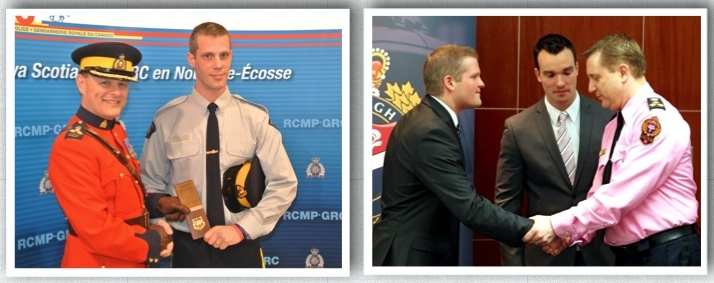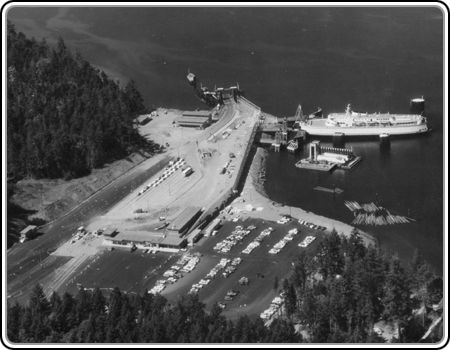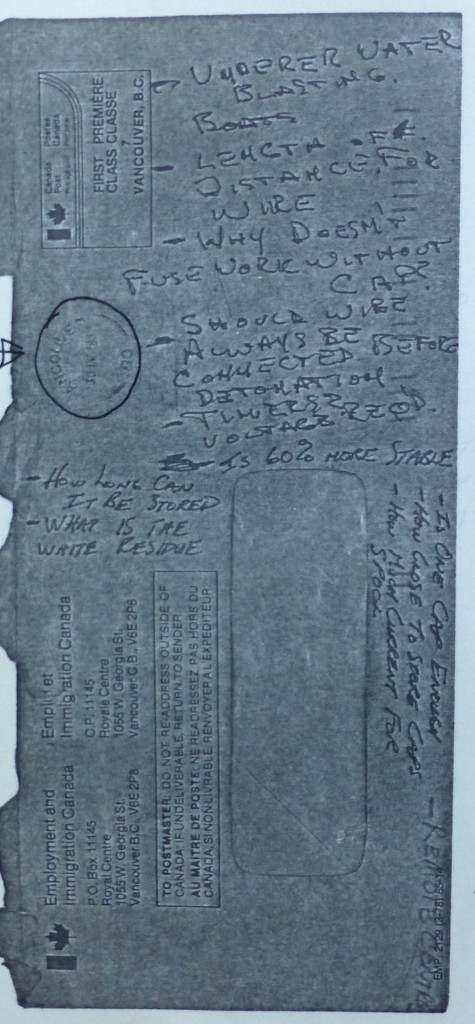Oversight of Police and Security Services
Web Source Photo: A barn burning in May 1972, was just one event in a series of criminal acts committed by Canada’s Security Service in the decade following enactment of the “War Measures Act“ after the “October Crisis” of 1970.
March 1, 2016 (8200)
October 1, 2017 (8400)
Concerns about Bill C51 and other terror Bills introduced since the “September Crisis” of 2001, follow a pattern similar to that of 1970 when domestic ‘terrorists’ challenged the Governments of Canada and Quebec. During that ‘crisis’ the Federal Government also turned loose Canada’s elite Security Service to act in a manner they saw fit.
So began a campaign of harassment, dirty tricks, illegal arrests, criminal acts and dozens of nefarious deeds that went far beyond the original intent of the law. Many at the highest levels of the RCMP and Government were aware of what was happening, but did nothing to reign in the Security Service. It was a decade of illegal police action that led to a break-up of the RCMP Security Service.
If anyone thinks our National Security Agencies – CSIS, CBSA and the Federal arm of the RCMP is above such tactics today, they would be wrong. There are plenty of examples since September 2001 and it has taken place because there is a wilful lack of oversight and because laws passed since 2001 including proposed laws such as Bill C51, support what might otherwise be illegal in Criminal Law or, at the very least, violations of personal privacy. In the United States, because of ongoing controversy, the Patriot Act (passed a week after September 1, 2001) was allowed to lapse on June 1, 2015. Whether it will be renewed or not remains an open question.
(Detective-Sergeant Harold McNeill, Retired)
Note: If you wish to skip the background discussion surrounding police, security services and terror, go straight to section #4 for the summary of events that followed invocation of the War Measures Act in 1970.
Note: Part 11 is now complete. Link here to: Conspiracy to Bomb the B.C. Legislature: The Grand Illusion as just one example of what happens when the security service is given free reign to act in a manner they see fit. That manner often acts more in favour of the Government and Security Service interests rather than in favour of the general good. As an example, after the judge overturned the jury conviction one of her final statements regarding the RCMP action in the case read: “They were clearly overzealous and acted on the assumption that there were no limits to what was acceptable when investigating terrorism,” the judge stated. “Within their ranks there were warnings given and ignored.”
Link here to Part III: Conspiracy to Rob the BC Ferry Terminal at Swartz Bay: Part III provides the details of a traditional conspiracy investigated by traditional police agencies without having to resort to the manufacture of evidence in order to build the case.
Part 1
(9044)
Abducted: The First Twelve Hours
A full set of photos from this story and a short introduction for the post appears on the
McNeill Life Stories Facebook Page (Link Here) (Note: All the photos, except the two from the Oak Bay PD, were captured from Web sources.)
“Except for my dogs, I am alone in a world filled with people.”
For people of all ages, but particularly the young, few things can be more lonely than being on a street full of people and the only looks received vary between pity, disgust and outright anger. Most street people are viewed as being worth less than the clothes they wear. They could go missing, be raped or otherwise sexually assaulted, even murdered, yet this often raises barely a ripple of concern from the public, let alone police circles.
If they are of native descent or part of a visible minority, it is far worse. In 2010 during the Olympics, I watched as two members of the “Red Shirt Brigade” (Volunteer Security) in Vancouver were openly antagonistic and physically aggressive towards a native woman sleeping in the doorway of a store that was closed for the night. This story traces the social conflicts which remain close to the surface in this bountiful country of Canada. (Photo Web source)
(Post: February 2016 2794)
(July 2018 4702)
Introduction
“In the Oak Bay office, it was nearing 3:00 am, as the night shift Sergeant, Constable and a Civilian Dispatcher were cleaning up the coffee room when the phone lines lite up. In the quiet hours, this usually meant an accident or similar emergency had shaken several residents from their pre-dawn slumber. In this case, two blasts from a shotgun were followed by the blood-curdling screens of a woman. So began a twelve-hour saga where a young woman’s life hung in the balance.”
Having lived inside the police system for thirty years, this story, and others to follow, explore various Oak Bay Police Major Crime files from beginning to end. Many of the stories including this one, contain additional discussion about social issues related to the crime. This particular file is used as a sample of how some criminal acts (or suspected criminal acts) can be quickly filtered to ‘inactive’ when the victim lives outside the mainstream. While this is sometimes done for good reason, discounting these crimes can have serious, unintended consequences in the mainstream as is demonstrated in eight interconnected chapters beginning in the early 1980s and extending to the present day. If you wish to skip the social interest sections you can read Chapters 3-7 for the present criminal case.
Chapters 1: A discussion of how the police and justice system filter is applied and how societal norms (reference the section on deviance) impact the events such as those described in this Oak Bay Police abduction case.
Chapter 2: A general description of the Greater Victoria area, the various police departments and of the area in which the crime occurred.
Chapter 3 and 4: Provides background on the victim. This is done as a method of demonstrating how some victims, because of age, sex, socio-economic status, mental illness or some other factor, are left vulnerable when society in general and the criminal justice system in particular, fails to render assistance.
Chapters 5, 6 and 7: Tracks the investigation from beginning to end. This is done to demonstrate why a high level of cooperation between police agencies is an essential component of effective law enforcement. This is particularly so when a crime crosses jurisdictional boundaries, be it local, provincial or national. The chapters also demonstrate how a small Department the size of Oak Bay is able to provide a full range, effective police service. It also demonstrates how closely police agencies in Greater Victoria usually (but not always) cooperate with one another.
Chapter 8: Outlines other cases, in particular, the recent murder of Tim Bosma in Ancaster, Ontario, as a means of demonstrating how an application of the police filter can have unintended consequences when a serial sex offender or murderer is at work. I am presently writing a story about how a serial rapist and murderer (Scott Ian McKay) was finally charged with numerous counts of rape and one murder, after several police agencies in Greater Victoria came together in common purpose.
Addendum 1: A paedophile in our midst. This part, which began in the mid-1980s, flowed back to the surface in July 2013. It involved a Boy Scout Leader who led the Royal Oak Group of which our oldest son was a member until leaving the troop after a serious injury at a Scout Camp retreat in Sooke. There is no suggestion our son was molested, but the danger was lurking just one small step away from our family.
(6449)
Police Members and their Oath of Office
Not only did these photo ops take place on the opposite sides of Canada, the police recruits being sworn in will be entering two very different policing worlds. Their employment adventure begins with the Oath of Office they have just swore or affirmed and from that first step, their careers will diverge in a significant way that can be traced to that Oath. The photographs actually provide a rather good visual example of that difference.
Photo Left (Web Source) RCMP Associate Commander Brian Brennan, personally welcomed officer Peter Wallace into the ranks of the RCMP in Nova Scotia, presenting him with his badge during a special swearing-in ceremony.
Photo Right (Web source) Chief Frank Eisner, right, shakes hands with Casey Jones, left, and Matthew King during a ceremony to welcome the two new constables to the Victoria Police Department. (Photograph Adrian Lam, Times Colonist)
Background
As outlined in a related article, Dispensary Raids Galore!, those ‘discretionary’ raids and arrests at marihuana outlets in Nanaimo, Mission and Sechelt will waste an impressive amount of police and court time and will cost hundreds of thousands of dollars in cases where the RCMP will eventually walk away empty handed.
(1564)
The Secret World of the CBSA
Does the beauty and welcoming nature of the new Vancouver International Airport (YVR), completed in time to showcase British Columbia and Canada to the world for the 2010 Olympics, belie the holding of dirty little secrets in the bowels of that sparkling facility?
Link Here to Part I of this series: Abducted: The First Twelve Hours
Link Here to Part II: Living in the Shadow of Mental Illness
Link Here to Part III: Mental Illness: A Rising Crisis on the Street
Link Here to Other Police Related Posts
Update, November 9, 2014: The inquiry into the death of Lucia Vega Jimenez while in custody at the Vancouver Airport is now concluded. Several recommendations were brought forth and it is clear from these recommendations that entire CBSA operation should be subject to the same independent oversight as that which takes place with regular police services. Under the current legislation, the entire CBSA operation is effectively shielded from any form of formal oversight and it was only after persistent probing by various media outlets that much of what is happening is now coming to light. For one summary, listen in to the CBC Early Morning Edition podcast.
September 19, 2014 (Original Editorial): Introduction
Sometimes the greater threat to our democratic way of life comes from within and not from without. I am not speaking of terrorists, jihadists or those who join murdering criminals like ISIS, I am speaking of how we respond to the threat. When we begin to dismantle all that which underpins our democracy because of them, they will have won.
As I researched the following post, I was astonished to see just how far we have fallen in the past decade. I fear that if we continue along this path for another decade, we will have become just a shell of nation which our grandparents and great grandparents fought for in first fifty years of the last century and which they and our great-great grandparents dreamed of when they first joined a line of immigrates and refugees to take up life in Canada. (From Facebook Post)
Would it surprise you that under the Beijing Airport, hundreds of people, thought to be ‘enemies of the state’ are detained after being pulled aside for a secondary search and questioning during entry? No surprise you say? In China, you could just as easily be whisked away on the street. What about Russia or other countries where human rights and the rule of law has little meaning in the sense we know it? Same answer? Probably.
How about the United States? Given the incredible size and strength Homeland Security and the many laws enacted since 9/11, there is little doubt a person, particularly a foreign national, could easily disappear without a trace at any airport or transportation hub in the country. Being whisked off the street would be just as simple.
Now, what about Canada, “the true north strong and free”? Do you think it possible thousands, perhaps tens of thousands of men, woman and children might be arrested and taken away to secret prisons located below major airports such as Vancouver, Toronto, Edmonton, Calgary or Winnipeg and at other, more or less secret facilities across Canada? Is it possible these prisoners have been stripped of all the rights we Canadians take for granted? Finally, is it possible these people could be whisked out of the country at the stroke of a pen, never to be heard from again? Not possible you say — we have far to many checks and balances. Well, think again.
This week after researching an article on the plight of a few immigrants and refugees, I was astonished to learn that not only is this happening, it is happening on a regular basis in cities and towns across Canada.
(2458)
Conspiracy to Rob the BC Ferry Terminal at Swartz Bay
Swartz Bay Ferry Terminal 1983 (Web Source)
On the May Day long weekend in 1983, a dozen police officers waited patiently with weapons at ready. The gang that commanded their attention had amassed a small arsenal of handguns, shotguns, rifles and even considered mounting a machine gun in the back of a stolen van. The gang also collected a box of dynamite and purchased blasting caps, radio transmitters, scanners, balaclavas and sundry other equipment to pull off a major heist. The gang leader was a convicted bank robber from the Vancouver Lower Mainland (White Rock area) who made no bones about killing if that should become necessary.
The gang had the planning down to the minute, the goal, a small fortune in cash that flowed through the Swartz Bay Ferry Terminal every long weekend. The only thing that stood between the gang and that goal was a small group of police officers and civilians who had quietly, deliberately, and secretly inserted themselves into the gang planning process.
Link here to Part I of this Series: Oversight of Police and Security
Link here to Part II of the series: Conspiracy to Bomb the BC Legislature
Part III Conspiracy to Rob the BC Ferry Terminal at Swartz Bay
An earlier post about BC Ferries posted on McNeill Life Stories: Thank you BC Ferries
1. Introduction
In Part II, a Conspiracy to Bomb the British Columbia Legislature, the crime was meticulously orchestrated over a five month period by 250 RCMP General and Security Service police officers. While many were only peripherally involved, two undercover officers maintained close personal ties with the two suspects.
During this period, the suspects were coached, cajoled, encouraged, threatened, and supported along a path that led them to the BC Provincial Legislature grounds in the summer of 2013. In culminating the crime, pressure cooker bombs where strategically placed on the BC Legislature grounds the night before the Canada Day celebrations of July 2013 were to be held.
As the crime was planned and monitored by the police, the bombs were inert, so there was no danger to the public. However, with considerable fanfare and live television following, the suspects were arrested in an ERT take down the next day at a Fraser Valley motel. Read the full story as linked above.
In this post, an Armed Robbery was carried out as part of a Conspiracy to Rob of the BC Ferries terminal at Swartz Bay. The commission and planning of these robberies were carried out by a half dozen suspects, while an equal number of police officers (Note 3) took turns following them, listening to their conversations, as well as collecting evidence as it became available. During the five-week investigation, the suspects had no idea police were listening in as well as watching their every move. It was a classic conspiracy investigation.
The investigation took place in early 1983 while I was working as a Detective with the Co-ordinated Law Enforcement Unit (CLEU), a joint forces operation that included five RCMP and six Municipal/City members. There was also a civilian support team of ten, including one pilot who worked with the surveillance teams. The unit was under the overall control of a Joint Management Team (JMT) made up of senior police officers and government officials from the Greater Victoria area.
The team was assigned complex multijurisdictional cases that often involved drug trafficking but periodically spun off to other criminal cases as in the present case. CLEU members also provided specialized support to local police agencies as needed. One example was an Oak Bay PD, in a case involving the theft of art. (Surveillance in an Art Theft). The cases regularly involved mobile and stationary surveillance as well as telephone and other listening device intercepts. As with most CLEU operations, there were never enough bodies to go around, so some intercepted call lines were only monitored on an “as needed” basis if things became hot on one or two other files.
So it was on this particular morning when, having a few minutes to spare, I grabbed a reel of EHUR recordings from a less active line. This was done periodically to catch up on the calls since the last logged entry. As usual with residential telephone lines, many calls were idle chitchat between family, friends and business associates. It only took a few days of listening to become familiar with the habits of the regular users, including their humorous attempts at cloaking some conversations in code. Following is a simplistic example.
“Hey Donaldson, you wanna buy some…”
“Carl you fuck, don’t use my last name and talk in code, OK?”
“Okay, okay, Jimmm…, don’t get pissed?. Hey, you wanna buy some “pizza”? Got some good shit.”
“Carl, we gotta be careful, cops might be listening.”
“Nah, cops are too stupid. Anyway, how many pizzas do you want, I’m making a pickup today?”
“OK, the usual, meet you later at the pond.”
Every group developed their own codes and almost all worried about their phones being bugged, but that never stopped any from talking as if their line was secure and as if their secret codes would confuse the police. A few might revert to a payphone, but when that happened, it was usually the same phone so the wiretap was simply extended to that line and intercepted only when they were on the line. That usually meant we had to cover off the call if possible. In the above example, Jim might have said at the beginning: “Give me thirty minutes, I’ll use the other phone.”
2. An investigative break in the Armed Robbery of the Brentwood Bay Liquor Store
On this particular day while listening to the early morning calls of a few days earlier, nothing much popped up until around noon (call time) when an unknown male (UM) made a series of calls to various stores looking to purchase a starter pistol. After a half dozen attempts including calls to Jeune Brothers, Ray’s Sporting Goods, Island Collateral, International Knives, etc., the man finally found pistols at Robinson’s Sporting Goods. They stocked several kinds, some of which could be purchased for as little as $20.00, so the UM told the clerk he would drop by later.
A similar pattern followed the next day calls, but this time they were made by an unknown female (UF) trying to purchase balaclavas. After contacting half dozen sporting good stores and no balaclavas to be found, the woman decided to settle for normal toques.
On the third day the line yielded pay-dirt when the UF of the previous day called from a pay booth to the target residence and spoke to the UM of the first day:
UM: “Hello” (this was followed by two faint shots from what appeared to be a small calibre handgun or starter pistol).
UF: “Police, oh God, you’ve gotta’ help us, somebody with a gun. I’m at the Waddling Dog Inn. Please send somebody.” (this was followed by normal conversation)
UF: “I just worked – we haven’t worked out what we’re uh how things are going. How’s it goin’? Can you hear that?”
UM: “Yeah, I didn’t un there’s not un yeah.”
UF: “Can you hear anything?”
UM: “Not much, no.”
UF: “OK, let me try again, just a minute.” (Again, two faint shots)
UF “We haven’t worked out our dialogue see we’re just practicing.”
UM: “Oh, that was pretty good.
The conversation extended a further ten minutes as the female was clearly self-conscious and uncertain as to whether her plea for help sounded convincing. The male attempted to reassure her but was more worried about whether the shots sounded realistic. The conversation suggested the two had a personal relationship. The call was traced to a phone booth in the parking lot at the Waddling Dog Inn at the intersection of Highway 17 (Pat Bay Highway) and Mount Newton Cross Road.
This call was the first break in an armed robbery that occurred a few days earlier at the Brentwood Bay Liquor Store in which two men wearing balaclavas and one threatening with a handgun accosted the store manager and stole the bank deposit bag containing nearly $7000. As the robbery was going down, the above female phoned the Central Saanich Police (CSP)office and made a report similar to her earlier practice call of a shooting at the Waddling Dog Inn.
Following is a partial transcript from the police tape of the robbery and shooting call:
Male Caller (MC): “This is the Liquor Store at Brentwood. I got held up by a man with a gun in a red van Licence number 12-34-AB.”
Dispatcher (Disp): “O.K.”
MC: “Towards you on Wallace Drive”
Disp: “O.K.”
MC: “The right-hand door was torn off.”
Disp: “Right-hand door torn off it, O.K. just stay on the line, was this an armed robbery?”
MC: “Yes, it was”
Disp: “O.K., what type of weapon.”
MC: “It was a revolver.”
Disp: “A revolver, and how many men.”
MC: “Two.”
Disp: (APB on Radio) “Liquor store in Brentwood Bay was just robbed, armed robbery, BCL 12-34-AB, a red van and its heading down Wallace Drive towards us. (to MC)”Just stay on the line, sir:”
MC: “O.K.”
Disp: (on the radio) “120 Central Saanich, contains two males, 120 Central Saanich.” (on phone) “Just stay on the line, sir.”
120: “120”
Disp: “We’ve just had a robbery at the Liquor Store (phone rings) vehicle involved is a red van #12-34-Alpha Bravo (rings) the van is proceeding north on Wallace Drive towards our office (rings), two males with a handgun (rings) revolver involved.
Disp (aside): “Stay on the line sir”
Disp: (answers another phone). “Central Saanich Police” (the sound of two faint shots can be heard)
Female Caller (FC): “Police, my God can you send somebody down to the Waddling Dog Hotel, there’s a man with a gun and somebody has been shot already – OH MY GOD.”
Disp: “O.K. Mam you said there’s .. stand by Mam hello (phone rings) “Just stay on the line sir.”
MC: “Yes, I’m right here.”
Disp: “Mam you said there’s, stand by, Mam hello.” (Caller apparently hung up) (rings) “Just stay on the line sir”
MC: “Yes, I’m right here.”
Disp: “122, 120 Central Saanich I’ve just had another report that there is a man with a gun at the Waddling Dog and someone has been shot, apparently the caller, a female has hung up, I have no further information on that nor a description.
120: “Central Saanich 120, I’m 100 yards off the Waddling Dog, I have Constable Henn, off duty, with me.
Disp: “10-4 description of the van was a red van BCL 12-34-Alpha Bravo,,, two males with a handgun, stand by O.K
120: “10-4, get some backup from Sidney and Saanich.”
Disp: “Standby sir, I ‘m just going to keep you on hold OK, but stay on the line.”
122 “122 Central Saanich”
Disp: “122:
122: “Do you still have the liquor store on hold?”
Disp: “10-4”
122: “Don’t let anyone in till I get there and lock the doors.”
Disp: “10-4 (then to male caller): O.K. police will be their shortly, secure all the doors. Hello”
Communication by radio and phone continued for several minutes as other units from Sidney RCMP and Saanich PD set up to assist. When CSP 122 arrived at the liquor store, the store confirmed the arrival with the dispatcher, then hung up. CSP 120 at the Waddling could find no evidence of anyone having been shot.
(Note: the manner in which the CSP Dispatcher, on her own in the CSP office, handled this situation, was a classic example of keeping one’s cool under pressure.)
Back at the Liquor store witness reports indicated the robbers were observed sitting in the red van in the parking lot. Things went sideways from the beginning as just when the robbery was about to go down, a woman drove into the parking lot and stopped to let the liquor store manager walk by in front of her car. Right after the manager passed, a passenger in a red Van threw open the sliding door, jumped out with his face covered with a balaclava, shoved a handgun in the managers face and ordered the manager to hand over the deposit bag. Instead, the startled manager dropped the bag. The robber scooped it up, jumped back in the van, but just as he was part way in and pulling the door closed, his partner hit the gas. This forced the sliding door to slam back open and nearly pulled the masked gunman from the vehicle.
As the witness vehicle partially blocked the exit route, the get-a-way driver cut short to the right and in doing so caught a parked car that ripped the sliding door off the van. It was left lying in the parking lot and it was pure luck the gunman was not squished between the two vehicles. Had that happened the case would have long since been solved and that would have been the end of this story.
As it was, an hour later, a CSP unit found the get-a-way van abandoned in a commercial parking lot off Keating Cross Road. It was soon determined the van was stolen earlier that morning from the long-term parking area at the Swartz Bay Ferry Terminal. Also stolen were two sets of BC licence plates from other vehicles in the same lot.
3. The Follow-up Begins
In a meeting with CSP investigators, it was clear there was no physical evidence, other than the phone calls made between the mystery male and female, connecting specific person(s) to the crime. It seemed likely those at our target residence were complicit in the robbery, but a lot more work was needed to pin things down to specific individuals.
While we carried out periodic regular surveillance of the target residence, another drug trafficking case was demanding considerable attention, so the best we could do was rotate between the two cases as priorities allowed. CSP provided additional assistance whenever needed.
Given both monitored residences were in rural, somewhat isolated areas, onsite surveillance was nearly impossible. The best we could do at the Saanich residence was station a car at each end of the through road, then conduct periodic spot checks as we drove-by. In the East Sooke case, the house was on an isolated dead-end road so one car could maintain regular checks when required. In both cases the houses had a single driveway and, as the parking areas were visible from the road, it was fairly easy to capture licence numbers of visitors.
In Saanich, it only took only a couple of days to come up with the tentative identity of the UM as being one John Dillinger who, it turned out, was a dangerous ex-con in his late-thirties. He was driving a vehicle registered to his name at a residence in White Rock, B.C. The man had a long criminal record with extensive entries for armed robbery and other serious crimes. FAX photos tentatively confirmed his identity and fingerprints were on the way.
It took a bit longer to identify the woman, but she was finally tracked to West Vancouver where she lived in an upscale high-rise apartment not far from the Lions Gate Bridge. She did not have a criminal record and nothing popped up on any of the Lower Mainland Police blotters. Given what little we could find about her background, how she came to be involved in an armed robbery was a mystery. As she was in mid-thirties, apparently single and a looker, it seemed likely she was drawn into a relationship with Dillinger, then some time later became an active partner in the robbery.
As for the regulars at the target residence, they were a mix of mid-level drug traffickers we hoped would lead us to bigger things in a Vancouver Island/BC based drug trafficking ring. As that had not yet happened, our new priority became the robbery.
4. Garbage Out – Evidence In.
In discussion with CSP, it was decided that in addition to upping surveillance on the targets we would also begin picking up the garbage at the residence. On checking with Saanich Public Works we learned the next pickup was two days hence so luck was with us as there had not been a pickup since the robbery.
 The possibility of garbage yielding solid evidence was a tact I periodically used when working in the Oak Bay Police Detective Office. As there was no prohibition in law, it was as easy as picking up that which a suspect trashed. It was amazing what criminal types were willing to throw away without a second thought and in one instance, at an upscale home in north Oak Bay, it only took a couple of pick-ups to find items relating to a fraud case that was currently underway at the Law Courts. The items pointed directly to the guilt of the accused, a man I knew well from previous investigations.
The possibility of garbage yielding solid evidence was a tact I periodically used when working in the Oak Bay Police Detective Office. As there was no prohibition in law, it was as easy as picking up that which a suspect trashed. It was amazing what criminal types were willing to throw away without a second thought and in one instance, at an upscale home in north Oak Bay, it only took a couple of pick-ups to find items relating to a fraud case that was currently underway at the Law Courts. The items pointed directly to the guilt of the accused, a man I knew well from previous investigations.
After sharing the retrieved information with the prosecutor in the fraud case and his relaying it to defence, it was not long before the defence lawyer came knocking at my door. The testy guy as much as accused me of having broken into the man’s home and taking the evidence. Because the defence lawyer was an irritating, arrogant little shit I declined to divulge the source of the information. When he left he was so convinced I came by the material illegally, the next day a subpoena arrived at the police office and early the following week I was on the stand in a BC Supreme Court trial.
It was a very short appearance, as only one question was asked and when answered the defence lawyer did not even bother with a follow-up. The answer given was enough to blow a hole in his defence as the Judge had no qualms about admitting the evidence. The lawyer looked at his client, shook his head, and closed his binder. A finding of guilt followed not long after.
The accused, a colourful con man with his cheery personality and fun-loving ways, was known as William (Bill) Thistle, and, as he has long since passed away, I used his real name. He was a favourite with the various fraud sections throughout the lower island and at one time he rented a giant billboard on the Pat Bay Hwy near Mount Newton Cross Road advertising Charter Cruising on his luxury yacht. At the time he was living in a 12’ X 12’ motel room less than 200 feet from the sign. Such were the ups and downs of the con game. (For more background, reference Note 1)
5. Garbage Day 1
Meanwhile, back on the robbery case, after joining up with the Saanich refuse collector, who just happened to be the collector on our home route in the Interurban area of West Saanich, we commenced pickups along the street just before the target residence. At the residence, I had clean garbage bags ready and after the pick-up, we travelled a couple of blocks where we meet a CSP unit, then headed back to the CSP office with our treasures. In the company of CSP Constable Jack Hill, we were gifted with a virtual trove of evidence relating to the robbery.
1. Brentwood Liquor Store Receipt: The night before the robbery, the group purchased a bottle of Dom Perignon. Dillinger used a $100 bill to make the purchase (and it was his good luck to get the $100 bill back the next day in the robbery money).
2. Brentwood Liquor Store Receipt date receipted a few hours after the robbery. It appeared one of the gang members attended the liquor store and purchased a cart full of liquor presumably using some of the money taken in the robbery.
3. Torn up Personal Cheque in the name of John Dillinger drawn on a bank in White Rock (cheque was only partially complete with no payee)
4. Brown Paper Bag with a pencil-drawn adiagram on the back showing the Brentwood Liquor Store Mall parking lot and get-a-way route.
5. One small White Canvas Bag containing several pieces of white, red and blue electrical wires; one spool of white 12 gauge wire on which a puller had been used; two smaller spools of 10 gauge wire; one piece of paper with a wiring diagram; one broken alligator clip (brass coloured); one silver alligator clip (intact); three small screws; one plastic container from Cal Van Auto that likely held a number of alligator clips.
Note: Cst. Hill packaged the above items and along with the wiring and alligator clips used to hotwire the stolen red van sent them to the crime lab for comparison purposes. The items were received back a few weeks later confirming sufficient match points in the cuts, colour, gage, etc., to confirm they were at one time connected.
6. Four pieces of blue wool (cut out in a circular shape about 5 cm across). Given the earlier phone calls regarding toques, it seemed evident these circular cuts of cloth were from the toques. (Crime Lab Report in footer)
7. Tags from one pair of “Paris” gloves purchased at Woodward’s (likely the pair worn during the robbery).
8. Two small diagrams (not immediately evident as to what was being described).
9. Several more Brentwood Liquor Store receipts. It appeared a lot of the money stolen in the robbery was being delivered back to the store in small bundles.
10. Prairie Inn Coaster with several names written on the back. None of the names were familiar to the investigators.
The garbage confirmed a least three of the regulars at the residence were aware of or helped to plan and carry out the robbery. It seemed likely Dillinger was the gunman, as we knew from voice ID he had made the calls looking for a starter pistol. Also, he best fit the description of the robber, had a record for armed robbery and seemed to be the leader in the group. The problem, we had no firm evidence to connect him to the crime.
The woman, of course, was solidly connected by the phone calls made as she looked to find a balaclava, then the two diversionary calls (the practice one and the one to the CSP office) at the time of the robbery. While it was all good evidence, it was still far to thin on which to build a solid case. If we arrested the group at this moment we might, at best, end up with a few minor Criminal Code charges depending on what was found in the residence. A decision was made to extend the investigation until more evidence was collected. Two days later the next jackpot.
6. Hot money to purchase an airline ticket
Detective Doug Bond and I followed Dillinger and a rounder from up-Island, Scooby Dube, to the Victoria Airport as earlier phone conversations indicated those living at the house were fed up with the Dube hanging around. Being such a “pain in the ass”, they were willing to pay his airfare back to Port Hardy just to get rid of him (see note in the footer). At the airport, Dube went to the Air B.C. counter and following several minutes of discussion, purchased a ticket (later found to be to Port Hardy via Vancouver). Doug and I observed Dube tender several twenties for the fare.
A complication arose when somehow Dube dropped his copy of the airline ticket in Dillinger’s car when the two went out for a toke. Shortly after Dillinger arrived home, Dube phoned and a pissed off Dillinger went back to the airport with the ticket. After Dillnger drove away and Dube caught his flight, Doug and I went to the Air B.C. counter and inquired about the transaction.
It was our good luck the ticket was sold after the regular cash count by the day shift so the payment, made with $20 bills, was clipped to the airline copy of the ticket and passed to the afternoon shift to add into their count. The cash was still in the drawer 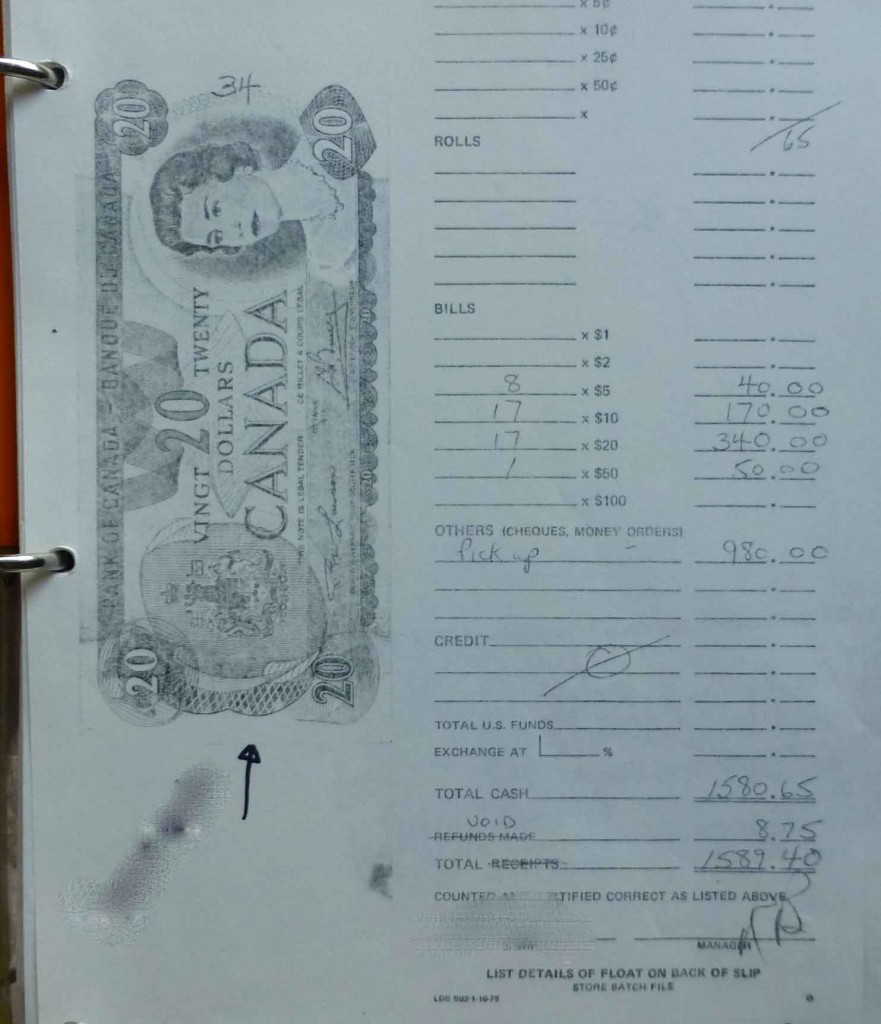 with the audit copy of the ticket attached.
with the audit copy of the ticket attached.
Both the ticket and cash were seized and on one $20 bill we noted the number “34” printed on each end. It was interesting to note that while Dube gave his own name for the ticket, he signed it (it had to be signed in those days) with the name Willy Wonka. Why? We had no idea, perhaps to many tokes over his short life.
The next day Bond and I took the bills to the Brentwood Liquor Store and the manager immediately identified the bill with the printed “34’s” as having been one of thirty-four $20 bills included with the stolen money. He recognized one set of numbers as having been written by himself and the other by one of the clerks. To see how meticulous the cash count was and why the manager recognized the printing on the bill check out Footnote #1.
Photo (file). On this bill, the one “34” (top) is clearly visible, the other, at the bottom, was faint in the copy, but readily visible on the original. The count slip to the right is from the Air B.C. count (17 twenties). The count slip from the liquor store would show “34” twenties as processed and part of the money taken in the robbery.
The store copy of cash count receipt was seized for identification purposes. While this was excellent evidence, the fact Dube was not in the city at the time of the robbery excluded him and even a charge of possession of stolen property would be pretty thin. We surmised someone, likely Dillinger, but possibly Wonka, had given Dube the money to purchase the ticket.
As evidence was still flowing to bolster a solid robbery case, it was decided to continue monitoring the phones and maintain periodic surveillance in hopes of connecting the rest of the dots. However, a day later, an outcall from the residence made by an associate of the gang, one Sean Penn, to a number in Vancouver inquiring about buying several .38 Special revolvers, changed everything.
The next day Penn phoned Wonka and asked if they still needed the radio to which Wonka replied “yes”. Dillinger then came on the line and asked Penn about the guns and Penn stated he would pick them up in Vancouver in the next day or two. The cost was $500 for all five. That same day Wonka phoned K-Mart looking to buy a scanner telling the store clerk it was for his (Wonka’s) father. Clearly, things were changing fast. With the intercept orders ending, RCMP Constable John Roung and I went to work applying for wiretap extensions with Roung working on the Wonka order and I, the Penn line. Writing that order would be my first since joining the squad a few months earlier.
As the original file now morphed into new territory our OIC, Inspector Hempstead, brought the matter before the JMT and an extension was approved the same day. The great thing about the JMT organizational structure was the ability to move quickly up and down the chain of command even in a matter of hours if needed.
7. The Ferry Robbery Conspiracy Begins
While the wiretaps provided good information, surveillance filled the blanks and those blanks proved mighty interesting. The day after the money pick-up at the airport, Constables Roung and Gilbert followed as Dillinger and Wonka drove to the Swartz Bay Ferry terminal. After parking, the suspects spent an hour wandering about making notes and 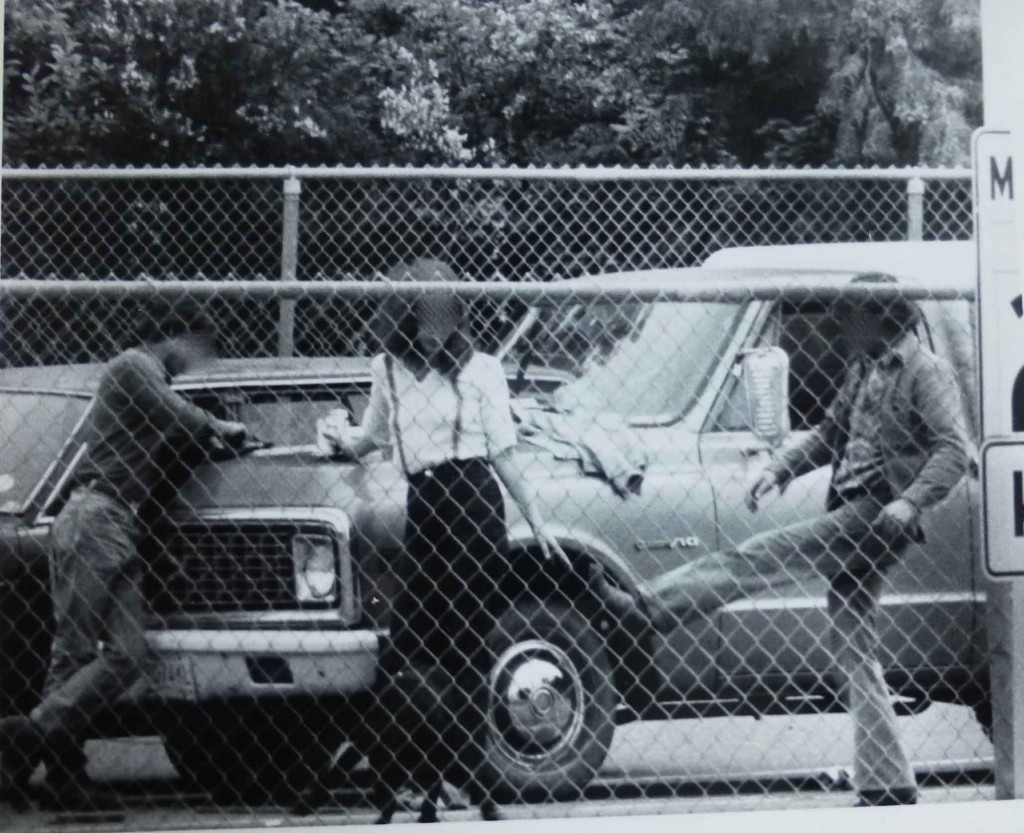 sketches. The same day Det. Bond and I observed Penn and Doe checking out the side roads around the terminal.
sketches. The same day Det. Bond and I observed Penn and Doe checking out the side roads around the terminal.
Photo: Taken from OP using telephoto lens.
Over the next few days we observed as various members of the gang drove to the Ferry Terminal where they spent several hours watching the movement of the tollbooth operators and other employees. Of particular interest to the group was the arrival and departure of the Brinks Armored Car. As there was always a lot of foot traffic around the terminal area, the movement of the suspects never drew any attention.
However, to provide a better vantage point for police, Det. Bond and I checked out properties on the west side of the terminal. After vetting the owner of one property, we made arrangements to set up an observation post (OP) in a wooded section that provided excellent coverage of the terminal parking lot and administrative building area. We were able to set up a tripod and over several days grabbed dozens of photos of the gang as they went their planning sessions.
Our best guess was a plan involving the robbery of a Brinks car as it made the pick-up from the administrative building. The gang now had the scheduled times for the armoured car and how the cash moved from the booths to the administration building. From this point, the watchword was caution, for, as yet, we had no idea when the robbery might take place.
8. Garbage Day 2
After making the bi-monthly pick-up and heading back to the CSP office this search revealed the following items:
1. An ‘accounting sheet’ with the names Mona. John and Willy. This was clearly our three main suspects in the robbery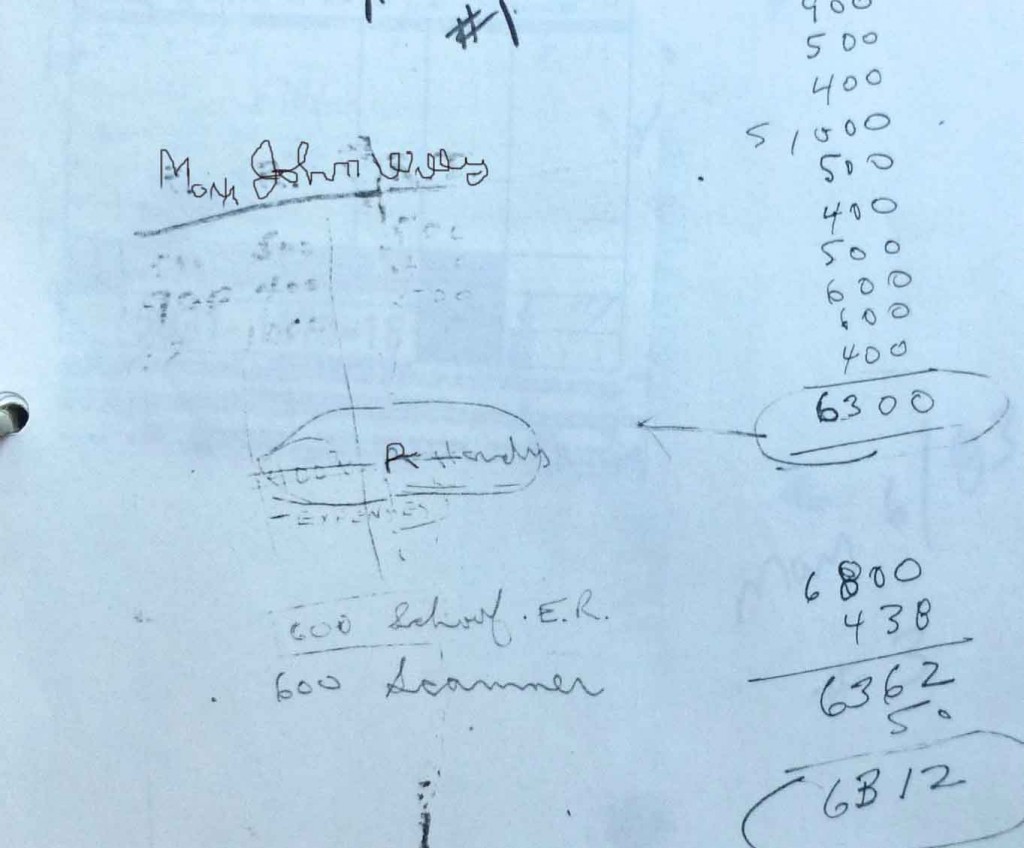 . The total count was $6300 and, as well, included a list of expenses; Port Hardy (cost of getting rid of the pothead); School fees for Mary Jane and $600 for a scanner. This brought the total within the range of that taken in the robbery.
. The total count was $6300 and, as well, included a list of expenses; Port Hardy (cost of getting rid of the pothead); School fees for Mary Jane and $600 for a scanner. This brought the total within the range of that taken in the robbery.
2. A torn page of lined foolscap with handwritten notes (photo in footer):
-
- 454 divided by 32 equals 14½ ozs, 1 pound equals 20,000
- coveralls, gloves, walkie-talkies
- check about caps at 4251 Blenkinsop, 477-6964 (note: this related to call #23 made by Mary Jane Doe to Web and Trace (a local blasting company) in which she inquired about blasting caps. The man at Web and Trace told her she could buy them and powder – all she needed was a driver’s licence. Mary Jane wanted a box of 50 caps and also inquired as to how long they would take to go off.)
- notes on balance sheet – scanner and lighter adapter $ on antenna.
3. A half dozen receipts from the Brentwood Bay Liquor Store (the store was quickly getting their money back). Between the Liquor Store, the Brentwood Bay Inn (comment below) and a few other local businesses, the gang was keeping the money local – no off-shore bank accounts for these folks.
4. Several other items of unknown interest at this time.
During this same period there were several calls related to purchase of dynamite and the use of blasting caps; about having purchased and tried the walkie-talkies and comments that a range of one mile was needed. Members of the group also spoke of having access of a pound of gold – melted down – worth $20,000.
9. Surveillance Humour at the Brentwood Inn
Over the years, surveillance always provided humour of one sort or another, either among the police members or those we were surveilling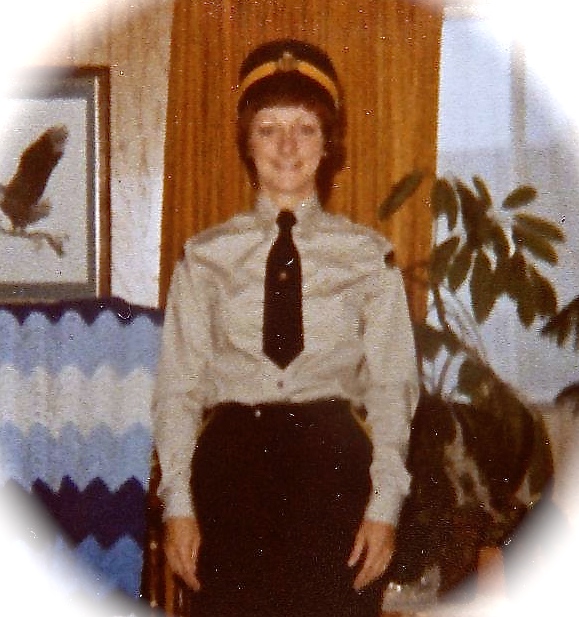 . One day when a phone call indicated the gang was having a special dinner at the Brentwood Inn, we decided to cover off the meal to see if anything interesting popped up.
. One day when a phone call indicated the gang was having a special dinner at the Brentwood Inn, we decided to cover off the meal to see if anything interesting popped up.
At the time Lynn Davis (later to become Lynn McNeill) was employed at the Oak Bay Police Office as Personal Secretary to the Chief Constable. Lynn came to Oak Bay from the Colwood RCMP where she worked for a short period as a Civilian Dispatcher after having joined the force as a Civilian Member in Campbell River.
Lynn was also a member of the RCMP Reserve (photo left, c1980) and along with her longtime friend, Cathy Gordon (photo below right, who would later to become the wife of Colwood RCMP member Constable Gordie Dash), the two young, single women became accustomed to police life while serving in the area of Campbell River and Comox.
Before joining Oak Bay (and meeting her future husband), Lynn spent several months touring the Interior of the Province as a Special Assistance to the IBCCS (Interior British Columbia Communications Team) and at one point helicoptered to the top of 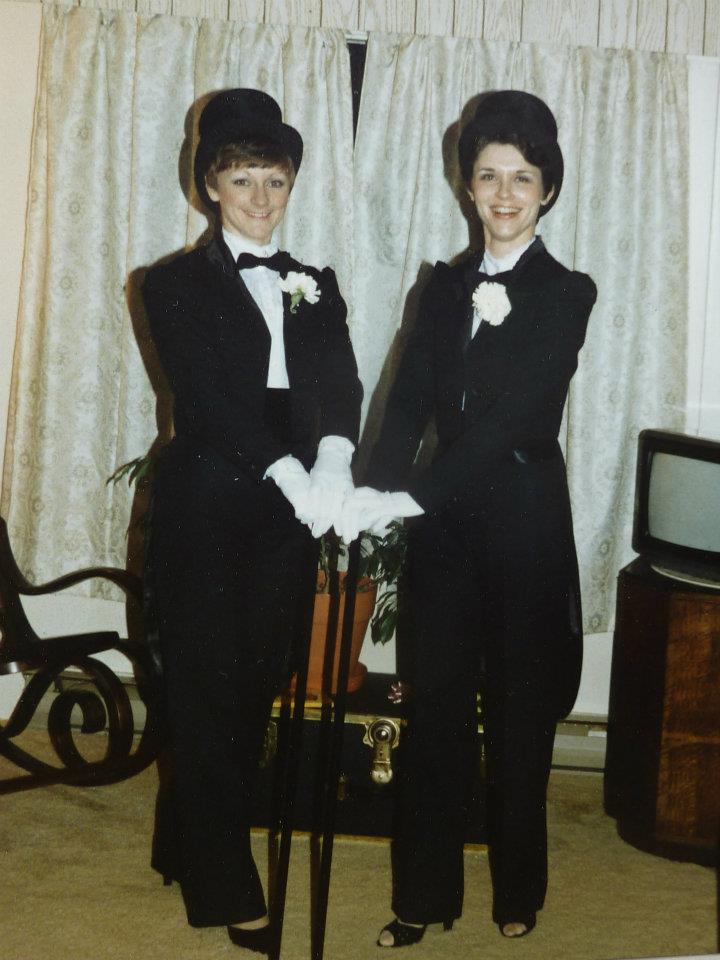 Mount Robson while installing part of a new communication system for the force. Lynn’s primary job was attending dozens of Interior RCMP Detachments and instructing members on use of the new radio system.
Mount Robson while installing part of a new communication system for the force. Lynn’s primary job was attending dozens of Interior RCMP Detachments and instructing members on use of the new radio system.
After coming to Oak Bay, Lynn occasionally accompanied me on surveillance when doing close quarter checks (e.g. restaurant walk-throughs, beer parlours, lounges, etc.). It was always less conspicuous than when a man or woman wandered in alone.
Photo (c1980): Lynn and Cathy as they get ready to escort a young man to his going away party just before heading to recruit training in Regina.
Back at the Brentwood Inn Lynn and I were using the CLEU surveillance van, but the only good OP by the Inn was marked “Residents Only”, so we took our chances. As the van had a periscope in the back with a camera mount we were able to get several photos of the gang as they arrived. A little later Lynn and I entered the lounge area, had a beer and checked out the group. It appeared the dinner was only for the regulars and likely a planning session. Nothing of particular interest popped up inside so we returned to the van.
As we awaited the gang’s departure, someone banged on the passenger door. We hadn’t noticed any of our suspects come out, so I got out and spoke to a man who identified himself as a local resident. He complained about my parking in a ‘Residents Only’ zone. Not wanting to identify myself as a police officer, yet wanting to keep the spot for another hour, I quietly pulled the guy aside, told him I was on a date with this new girl and that we had just finished dinner, had a bottle of wine “and you know…” (wink, wink, nod, nod). The guy was quick on the uptake, winked back and said something to the effect of ‘take your time buddy’.
After climbing back in I told Lynn it was just a neighbour and it was OK if we stayed, but never told her what I had said to make it OK. After a few minutes elapsed I stretched out, put my feet against the side bench telling her I had a cramp in my leg. As I pushed back and forth the van started to gently rock. I did this a couple of more times over the next hour and she thought I was just being weird (as usual). When the gang left, we grabbed a few more photos and then on the way home I told her how I had got the neighbour off our backs. She punched me, called me a not nice name and we still chuckle about that little interlude in our pre-married life.
Back on the case, it was around that time Mona Lisa dropped off our radar. We all had the feeling she was in well over her pretty little head, but not sure whether she just had falling out with Dillinger or whether something more sinister happened. We spent a day in Vancouver checking around her apartment, but nothing was found, her car was not located and the phone line went silent. We knew Dillinger was a dangerous man, but there was nothing in any conversation or observation to suggest he might have been responsible for her disappearance. He had made a couple of calls to her residence, but when no one answered, he stopped calling. To begin poking deeper into her activities would clearly jeopardize the investigation, so the decision was made to continue as planned.
10. The Royal Bank in Brentwood, a Possible Target
While the gang possibly had access to some gold, it appeared they were still struggling with money problems. Perhaps they donated a little too much back to the liquor store and the rest may have gone up in smoke at those late night parties. But, for our crew, things took a possible turn for the worse when Dillinger, Wonka and another were observed wandering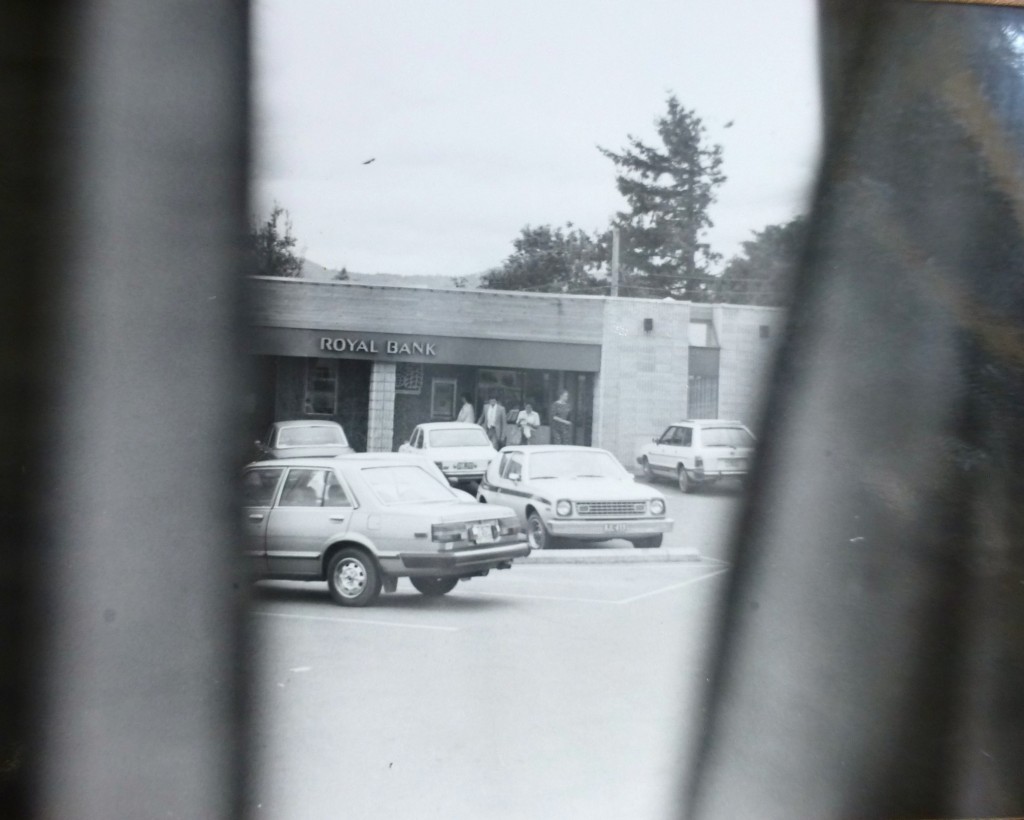 around the Royal Bank in Brentwood. That he was an experienced bank robber having knocked several outlying banks in the lower mainland, the RBC would be his cup of tea.
around the Royal Bank in Brentwood. That he was an experienced bank robber having knocked several outlying banks in the lower mainland, the RBC would be his cup of tea.
Photo: Taken from a surveillance van.
As we were reasonably certain the group was in possession of several handguns, two or three rifles and probably a stash of dynamite and other equipment, the threat of a bank robbery to grab a little extra cash was real and immediate.
The RCMP members in our section were getting significant blowback from a senior RCMP Inspector at HQ who was monitoring the progress on the Ferry Conspiracy and, although he was not attached to the JMT, he wanted the gang taken down immediately. If that happened we would likely be left with a rather shaky robbery case. To his credit, Inspector Hemstead stood his ground and along with other members of the JMT, cooler heads prevailed and the surveillance was allowed to continue. But, just in case it all blew up, we doubled up on the RBC security during banking hours.
Det. Bond and myself were assigned to an inner perimeter stakeout in the banks parking lot. Using a borrowed camper truck with shotguns at ready, our instructions were clear – if any member of gang happened to get through the outer perimeter and showed up in the parking lot, they were to be immediately arrested at gunpoint.
It was a tense time and while the gang was well covered with several CLEU and CSP units, it was hard to predict how things might evolve given Dillinger’s dangerous offender history. A running gun battle was the last thing we needed. I rather think our Inspector (Einer Hempstead) was more than a tad nervous as he and his partner had at one time been in a running gun battle with a couple of bank robbers in a chase that extended from downtown Victoria, out the Peninsula to North Saanich and then by boat into the waters of Brentwood Bay before the robbers were apprehended. I think Inspector Hempstead was shot in that little escapade. Perhaps someone who knows this story firsthand could help me make any needed corrections.
Following the second day of full coverage, phone calls and other movements suggested the bank was off the list as it appeared Dillinger had come up with several thousand in seed money from an associate in Vancouver. A greatly relieved crew pulled back and the Ferry Terminal and Brinks Armored Car were again given top billing.
11. Decision Time after Garbage Day 3.
As the days slipped by, it seemed increasingly likely heist would go down on the May long weekend, although there was no evidence this was a sure thing. It seemed likely as it was a time when cash flow at the terminal was usually at a maximum and in excess of $200,000 could flow through the system as cash was king and credit cards were still a second or third choice for many customers.
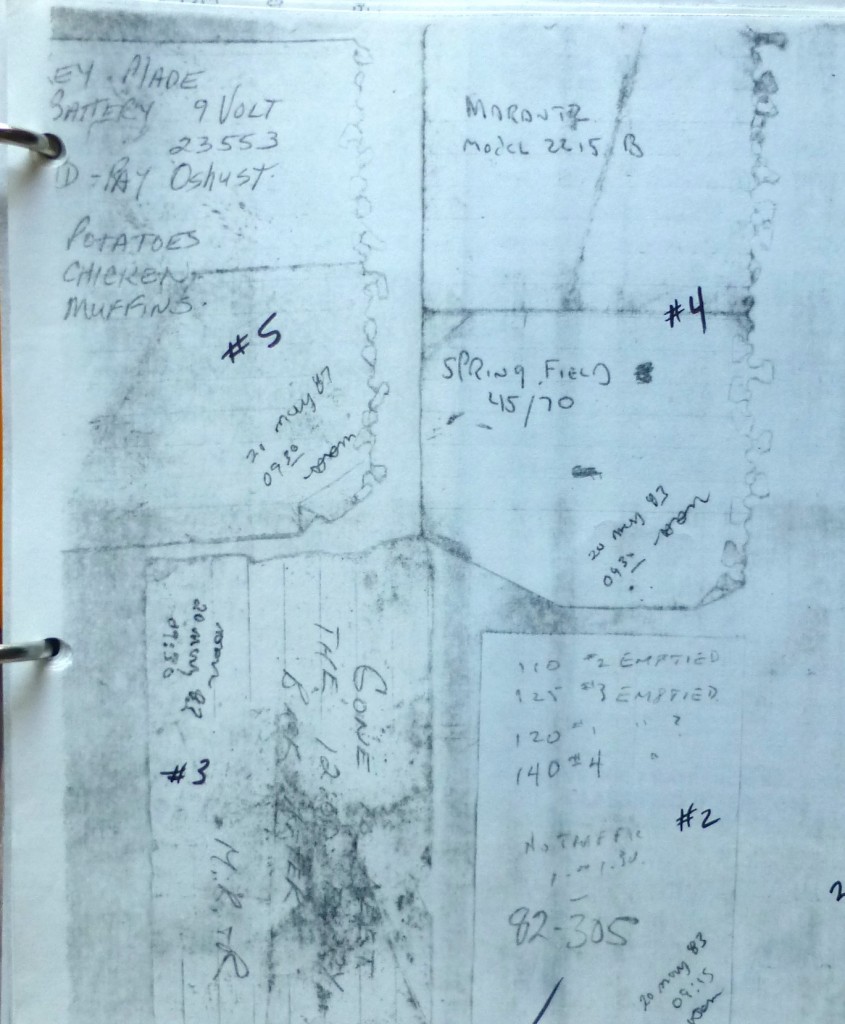 As we still had no idea where the gang might have stored their weapons and dynamite, this was of great concern. Given the diversionary tactic used for the liquor store robbery, it seemed certain the dynamite would be used to create a sizeable distraction. However, we had no idea where or where that might be, and with the number of weapons now believed to be in possession of the gang, there was the potential of a small war breaking out if things went sideways.
As we still had no idea where the gang might have stored their weapons and dynamite, this was of great concern. Given the diversionary tactic used for the liquor store robbery, it seemed certain the dynamite would be used to create a sizeable distraction. However, we had no idea where or where that might be, and with the number of weapons now believed to be in possession of the gang, there was the potential of a small war breaking out if things went sideways.
Just before the week-end the garbage pick-up was only marginally productive, with a few liquor store receipts, on one of which the Brinks money pick-up times was noted and another suggesting two more rifles, a Murants model 2215B and a Springfield 45/70 were now in possession of the gang (note photo left).
With the amount of weaponry increasing by the week, the decision was made to pull the pin and arrest the subjects if they began to move toward the ferry terminal over the long weekend. We would take a chance that enough additional incriminating material would be found in the residence or that, as in this type of case, one or two of the lesser gang members was willing to roll over and provide evidence against others gang members.
Well, you guessed it. The gang remained absolutely still through Saturday, Sunday and Monday. No one moved and no intercepted calls indicated they were about to move. Our entire crew was at ready, overtime was racking up by the hour and management was becoming increasingly anxious. The Inspector from RCMP HQ, who had now gained a seat with us, was becoming increasingly agitated. When the last ferry departed on Monday afternoon and all was quiet, the decision was made to do the takedown the next morning, May 24, 1983.
At a final meeting in the CSP office that Tuesday, all members were briefed and assignments made. Because it was likely weapons and explosives were being held at the residence, it was decided to make the arrests, if possible when the main gang members were split up and driving in rural areas. Det. Bond, Roung, Gilbert and myself were assigned to take down Dillinger and others who might be in his company. Immediately after his arrest, others would be picked off as quickly as possible.
Early that afternoon a phone call indicated Dillinger, Wonka and Doe were heading out from the residence. Close in surveillance picked up on Dillinger’s vehicle which was now sporting a set of stolen licence plates. As the suspects drove through a rural area of south Central Saanich, two CSP marked units and two CLEU unmarked units closed in and made the stop.
The three occupants surrendered without incident. No weapons were found and all were taken to the Central Saanich Police for processing and then lodged in Victoria Police cells pending a first court appearance the following day. Others were similarly taken into custody without incident. It was a rather anticlimactic end to a case that had run about five weeks from beginning to end, but there were still dozens of loose ends to cover off.
Oh, and a humorous event took place during the takedown, for which I was to pay the price in ribbing. When we initially left the Central Saanich office, I was assigned to travel with two uniforms (Constable Jack Hill and one other) in the primary marked unit that would do the pullover. I jumped in the back (the prisoner’s seat) with my shotgun and felt quite secure as there were no door handles or window winders on the inside and, as well, a Plexiglas screen between the front and back that completed the seal. During the hectic moments when the suspects were being taken down at gunpoint, I remained locked in the prisoner’s seat and was not released until the prisoners were handcuffed.
12. Search of the Residence
After the search warrant was issued Bond, Roung, Gilbert and a few others along with myself, attended the residence and the following items seized:
1. Four Portable radios (reference calls 21, 22 and 25)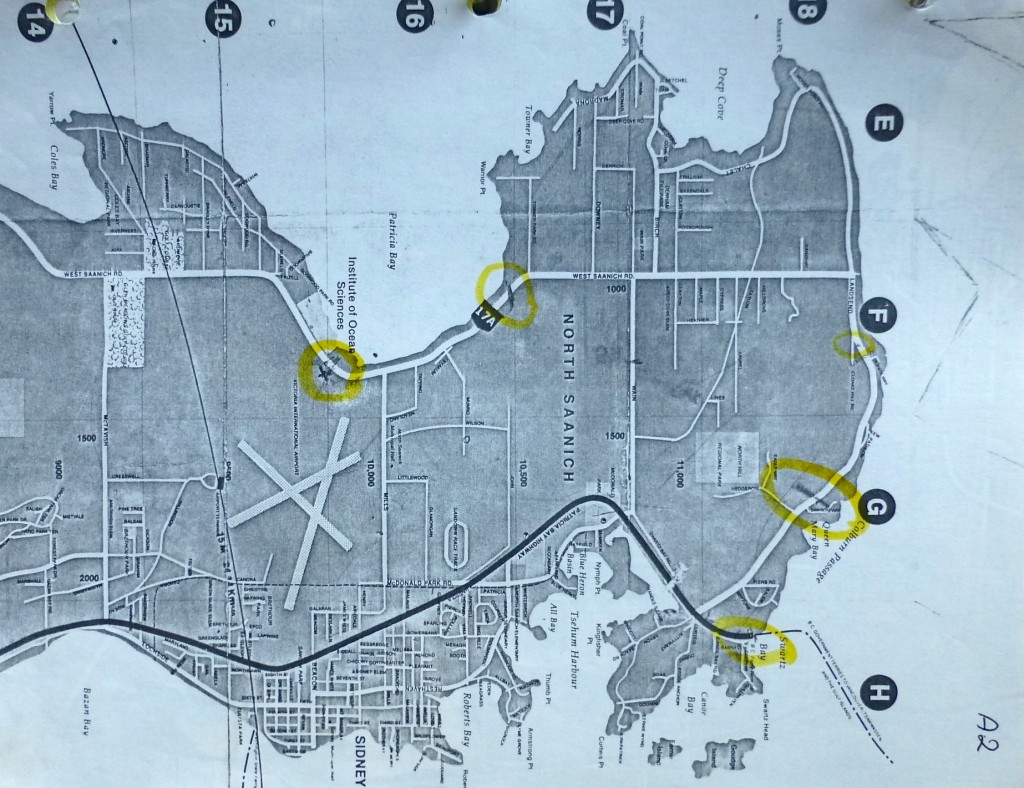
2. Map of North Peninsula with yellow circles at (right and footer):
-
- B.C. Ferry Terminal
- Two circles on Lands End Road (surveillance previously showed gang members checking out various side roads and waterfront access)
- Ocean Sciences Complex
- Commerce Mall with RBC Branch and Trafalgar Mall
- Target residence
3. Envelope with return address of Employment and Immigration date stamped one week after the Liquor Store Robbery.
4. Handwritten on front:
(My Note: Over time sticks of dynamite will “weep” or “sweat” nitroglycerin. Crystals will form on the outside of the sticks causing them to be even more shock, friction or temperature sensitive. This creates a very dangerous situation. While the risk of an explosion without the use of a blasting cap is minimal for fresh dynamite, old dynamite is dangerous (Wikipedia)).
-
- Is one cap enough?
- How close to store caps
- How much current for spool
- Remote Control
5. Diagram of Swartz Bay Ferry Terminal including passenger area, washrooms, offices, radio frequencies for terminal and golf carts.
6. Small sheet of paper listing
-
- Cost of boxes 17½ X 11 7/8 X 6 ½ ($175.00)
- Municipal Maps
- Gloves, coveralls, stainless wire
- Phone numbers of various people
7. Sheet of paper listing various items
-
- Police Codes (e.g. 10-29, 10-7, 10-6, etc.)
- “Plant Hindsight Score V (???) 10 spd Wed P.M
- Small wagon drops off to pick up boat
- Van picks up boat driver and to sting (?)
- A.B. detonates after Armie goes by (10 min)
- A.B. leaves after Van goes by
- Boat to Agua
- Fisherman fish until 5:00 pm
- Go Home
- Try scan from small wagon
- Try walk and talk from P. Bay to surveillance
- Try to detonate from Pat Bay to surveillance
8. Ten pages of radio frequencies and 10 codes
9. 12 gauge shotgun and case
10. Small notepad
-
- caps, boat and racks, pump
- gloves (2), hat, coveralls
- bike and accessories
- Dirt Bike
- Helmet
- Mun. Maps
- Harness
- Dent ________
11. Envelope with diagram on front
-
- diagram appears to be around the intersection of Raven Croft
- (note: Raven Croft is one spot circled on larger map) code 10-72 B&E Loc 2090
12. Various radio equipment
-
- Realistic scanner (20 channel 2020)
- AM-FM scanner, Model 20-112, Serial 2-048691 with car adaptor
- 2 audio source research speakers (back) with three clips on back and silicone on the back (later identified by the owner as stolen items)
13. One 30-06 Alpine Supreme, bolt action, rifle with 4X banner scope by Bushnell in a leather sling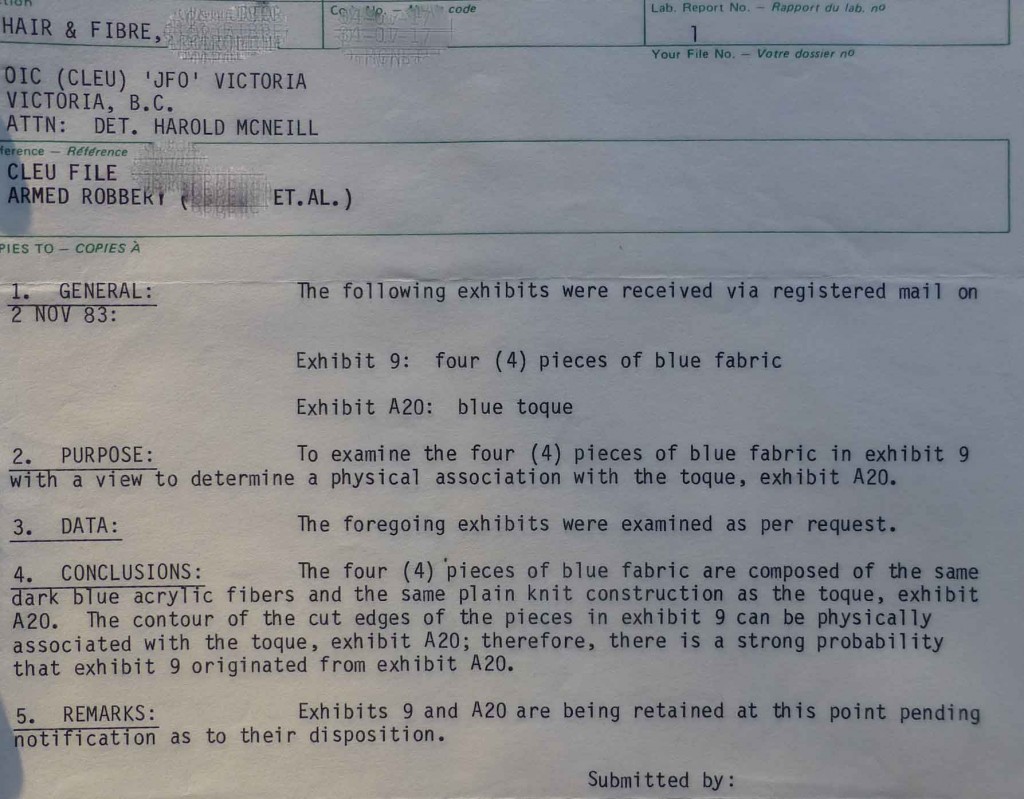
14. One .308 Winchester Remington – Mohawk 600 S/N 6948200
15. One .22 calibre Cooey Model 60 repeater
16. Blue Balaclava (see crime lab report, photo right)
17. Two toques (one orange/green, one orange/brown)
18. One black leather side holster
19. One set of handcuffs
Although we thoroughly searched the residence, surrounding the property and other locations, we could not find a trace of the five handguns or the dynamite. All the accused lawyered up so no further information was forthcoming from their end.
But, you might ask, what happened to the elusive Ms. Mona Lisa. Shortly after the arrests, a telephone call suggested she was back at her apartment in West Vancouver. The West Van PD was alerted, picked her up and lodged her in their cells pending pick-up and transfer back to Victoria.
The following charges were immediately laid against John Dillinger, Willie Wonka and Mona Lisa regarding the Liquor Store Robbery:
- Steal money while armed with an offensive weapon;
- Using a firearm while committing an indictable offence
- Theft of a motor vehicle and contents
- Possession of stolen property over the value of $200.
Some time later, a single charge against John Dillinger, Willy Wonka and Mary Jane Doe consisted of conspiring together and with other persons unknown to commit an indictable offence of robbery, to wit, to rob a sum of money the property of the British Columbia Ferry Corporation Terminal at Swartz Bay near Sidney, County of Victoria, Province of British Columbia, contrary to the Criminal Code of Canada.
13. Preparing the Case
While the investigation only took five weeks from the time of the first intercepted call connecting the group to the liquor store robbery, it generated a pile of material that needed to be catalogued and prepared for court.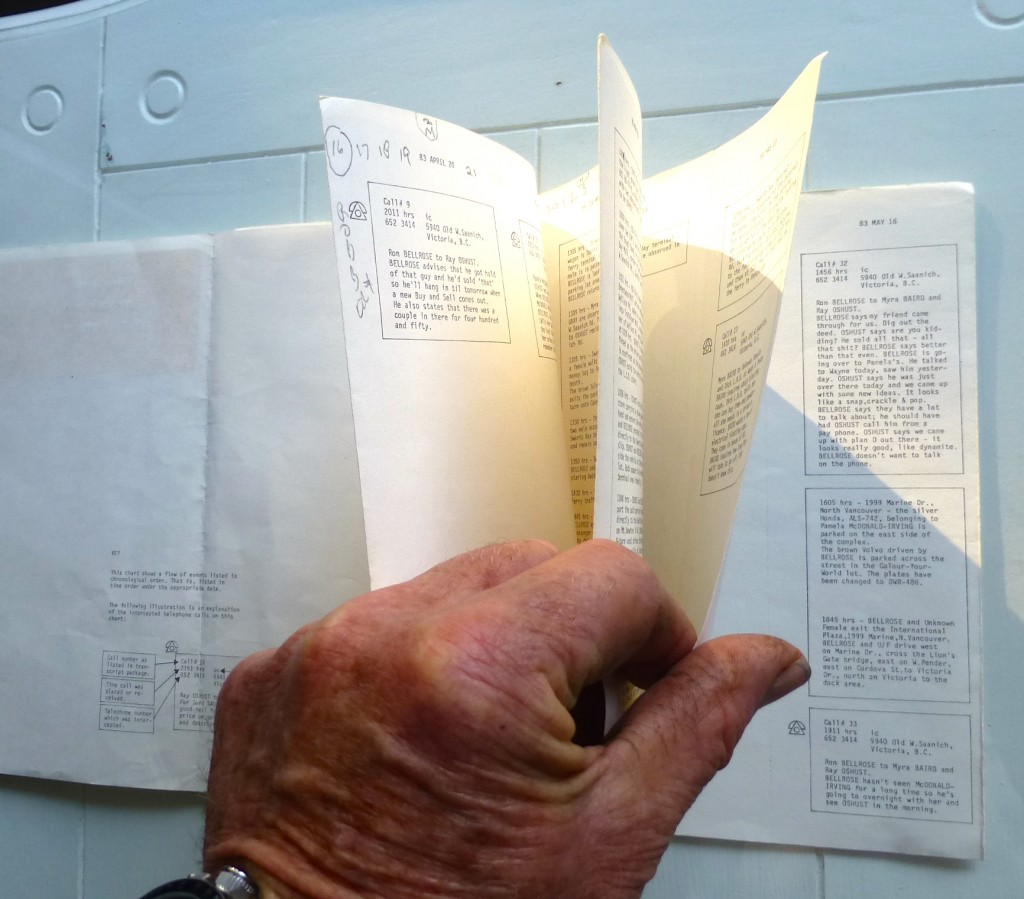
As wiretap conversations made up a significant part of the evidence, verbatim transcriptions had to be prepared, catalogued and placed in binders for distribution to the accused persons, defence lawyers, prosecutors and others. It also took the better part of two weeks to work through various documents and property lists to organize the connections between those items and relevant phone calls, exhibits and surveillance notes of various officers and civilian witnesses. While I prepared the initial full typewritten list of items expected to be used, Constable Roung added to that list and made an excellent chronological flow chart for use by the prosecutors when presenting their respective cases.
Photo: The spreadsheet made by Cst. Roung, continued for 35 pages. The sheet was painstakingly made at a time when computers were more of a novelty than an essential piece of equipment as in today’s police office.
While we could connect the main gang members to the robbery and ferry conspiracy, there were still holes in the case that would best be filled by turning one of the accused into a crown witness. Several names were discussed and tossed aside as not having a comprehensive knowledge of the leader of the gang, John Dillinger.
The weak link appeared to be Mona Lisa, whose actions in the robbery was limited to the phone calls she made looking for balaclavas and then placing the diversionary call to the Central Saanich Police. Those two items and her association with the Dillinger were sufficient to convict her as being a party to the offence. That provided the leverage we needed to possibly turn her into a crown witness. The fact that we had later learned she had skipped town and laid low in California while the ferry robbery plans were being developed, made for an easy decision. As far as we could tell, prior to the liquor store robbery she was squeaky clean, was a divorced mother with two young children and, as sometimes happened, had been drawn into an affair and later a crime by a cunning and dangerous man.
After some preliminary discussions between ourselves, the prosecutor and her lawyer, Ms. Lisa attended the Oak Bay Police office and provided a complete statement. Although Dillinger was being held in custody, his past and present criminal connections suggested he or an associate might seek to intimidate Ms. Lisa once word was out that she had turned on the gang. Constable Roung made an application to have the woman placed, at least temporarily, in the witness protection program until the court proceedings were complete, then longer if necessary. In the program, she was provided with a modest living allowance and moved to a temporary location out of the country.
In addition to a full statement and as a further show of good faith, she took Constable Jack Hill and me the exact spot where she had tossed the starter pistol in the ocean off the Sidney waterfront. On January 24, 1984, some eight months later, an RCMP diver was called in and not only did he recover the starter pistol, he also recovered 3 spent and 5 live cartridges. Given the generally violent nature of the rip tides in the waters off the coast of Vancouver Island, it was an exceptional find.
Following is a few key items included in Ms. Lisa’s statement:
Met with John during week previous to the liquor store robbery and he indicated some plan underway – would pay off well financially or else it would be the end of everything. He was leaving for the Island the next day. I followed in my own car later that day to meet him.
John made all the plans on the liquor store robbery telling me the only way I could be connected was if he or Willy divulged my identity. John fully expected we would get upwards of $100,000 in the robbery as the bag was always stuffed. He stole the get-a-way van at the ferry terminal and Willy was the driver for the robbery. I was present when discussions took place about acquiring guns and when they started planning for the next robbery. They had much bigger things in mind.
I was also present when discussions were held about obtaining dynamite and other items for the ferry robbery. At that meeting one of the people stated the police had rented an apartment next to his so they could keep an eye on him. Still later someone stated the dynamite would be used to blow up a car or phone booth. They had a plunger that apparently would be used to set off the dynamite. John had obtained a large handgun, he called it a magnum, the one he used for the liquor store robbery. Sean showed us some eavesdropping equipment he said he could hear through walls with.
A couple of days before the robbery John and I made calls looking for balaclavas, but couldn’t find any. Ron purchase two blue toques I cut holes in them for the eyes. Ron also bought some leather driving gloves at the time he purchased the toques. I went to Waddling to test the starter pistol and practice the call.
The night before the robbery, John plunked down a $100 bill to buy a bottle of Dom Perignon to celebrate. The next morning John went to the ferry terminal and stole a van. He also stole two other sets of licence plates. After the robbery John complained about Willy being a lousy driver as he had ripped the door off the van and John nearly fell out. John was very disappointed there was only about $7000, but on the other hand he was happy to find his hundred-dollar bill was included in the cash.
I later asked John whether he would have used the gun and he assured me that if it came down to him or the liquor store manager, he would shoot. It was at that point I realized just how dangerous John was and that I needed to put some distance between the crew and myself. That was went I decided to leave for California for a couple of weeks.
John gave Dube the money to fly to Port Hardy as he, John, just wanted to get rid of the man as soon as possible so they could get on with planning the ferry robbery, then he later told me about his ingenious plan to rob an armoured car. His plan was to steal a van with back opening doors. They would then back up to the armoured car, fling open the doors where they would have a machine gun mounted. He said it was an ingenious idea used to rob an armoured car back east. He was visibly excited and mentioned that on the long weekends there was a lot of money at the ferry terminal.
When I decided to leave and was heading back to Vancouver, John decided to come with me and while there we went out for dinner a couple of times and on one occasion I went with him while he purchased three balaclavas. One was orange I think. When he finally left to go back to Victoria, I packed up and headed to California. I never told him were I was going.
When I got back I spoke to John on the phone and he said all was good to go and that I should just sit tight at home. He said that after it was over they would all hunker down for a while, but once things cooled we would never have to worry about money again, that we’d even go to Paris on a Concord. He said they had a stash of dynamite and several guns including a very special Belgium handgun. He referred to the others as his “up-coming guerrilla friends”. I wanted no part of it so decided just to keep quiet and not see him. That was the last time I saw John until we were arrested.
Signed Mona Lisa.
14. A quick trip to Port Hardy
As part of follow-up interviews, I made a quick flight to Port Hardy to interview Scooby Dube. As a special treat, it was the first time I had a chance to catch a ride on a Beechcraft A90 (Super King Air) the RCMP’s first venture into turboprop. At the time I had several hours as the pilot in command on the Victoria Flying Club’s, Beechcraft Musketeer, the granddaddy of the King Air. The Super King Air was a flying treat, and as an added bonus the weather was perfectly ‘shitty’ in Port Hardy, so I was able to watch the pilot execute a full ILS (Instrument landing) approach to the airport.
I would be in Port Hardy less than two hours as by prior arrangement the Port Hardy RCMP had picked up Dube and brought him to the Detachment Office to await my arrival. As expected, Dube was a basket case by the time I spoke to him as he was certain he was being charged with armed robbery. The best we could get from him, and it was an important point, was the fact that Dillinger had given him the twenty-dollar bills used to pay for his airfare. Dube even watched as Dillinger took those twenties from his wallet. Circumstantial? Yes, but in the context of other evidence, was another nail in Dillinger’s coffin.
15. Case Conclusion
After all the paperwork was submitted to the Crown on both cases, our crew devoted full attention to other cases, some of which were running simultaneously to this file. The East Sooke and Victoria “Cultivation and Trafficking in Psilocybin” (Magic Mushrooms), remained hot, so that kept Detective Bond and myself busy in East Sooke. It would be the first time either of us engaged lock specialist to gain entry to a building and taking several photographs of an ongoing grow-op.
It was likely one of the harder cases for the lock guy, John Deering, as we had to bushwhack our way in through acres of forest and undergrowth 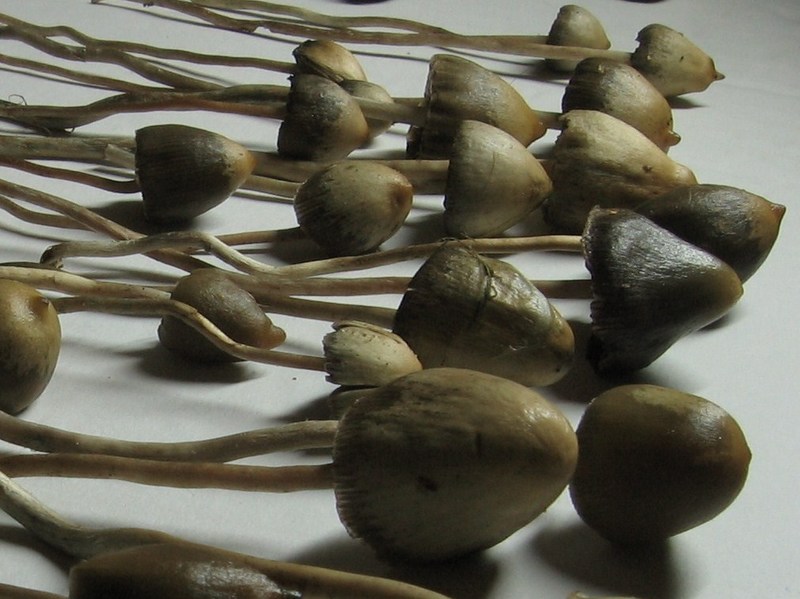 in the dead of night. Even though Doug and I had made that trip before (several times in the daylight), it was hard slogging at night that was completed for the most part without a light as the residents were present when we made the entry.
in the dead of night. Even though Doug and I had made that trip before (several times in the daylight), it was hard slogging at night that was completed for the most part without a light as the residents were present when we made the entry.
While ‘shrooms’ were in seasonally plentiful supply in the forests of BC, they were mostly harvested by a diehard hippy community for personal use (I suppose they were the original “Get Fresh” people).
Photo (Web Source). Wild shrooms. Somehow those little guys look vaguely familiar. I can see why it might blow someone’s mind if they ended up in the wrong place.
For commercial purposes, grow operations provided the best bang for the buck and the people we were tracking, did it in grand style. Part of their operation even served as the subject for a doctoral thesis on the commercial production of psilocybin.
The operation was of sufficient sophistication that suitcases filled with dried mushrooms were being transported by hired hands to Edmonton, Calgary, Saskatoon and Winnipeg on a regular basis. The story will be written at some future time and will include a connection that took me all the way back to my time as a Crash Rescue Fireman with the US Air Force in Cold Lake. That case was additionally significant in my life as it resulted in a major conspiracy trial involving seven co-conspirators persons, seven defence lawyers and ran for several weeks through the late spring and summer of 1984. The trial nearly caused Lynn and I to postpone our wedding plans for July 27 in Cold Lake as I was only released from court the afternoon before we were to leave.
As there was so much going on with active cases, it all but slipped from our minds that accused people in the Brentwood Liquor Store robbery and Ferry conspiracy cases, all plead guilty to the main charges. As time permits I will check the Times Colonist records to see what sentences were handed. Perhaps another member who reads this story can let me know the outcome.
Harold McNeill
Detective-Sergeant (Retired)
Notes
1. Bill Thistle, the Affable Con Artist
On one occasion while I was in uniform fundraising for some charity in front of the Fort and Foul Bay Liquor Store, Bill came out and borrowed $20 “as he was a little short of change at the moment.” A few weeks after Christmas, when we chanced to meet at a coffee shop on Oak Bay Ave., he pulled out a wallet stuffed with 20’s, 50’s and 100’s and offered me a $100 to repay his debt. I declined, as I was quite satisfied with getting back my twenty. Such was the man and his flashy ways.
How he ended up dead in an upscale home in a Deep Cove, a home he shared on a part time basis with the attractive wife of a dangerous drug dealer who was serving to a long term in penitentiary, will have to wait for a future post. Now back to the case at hand.
2. Liquor Store Money:
The statement of the Liquor Store Manager is provided as sample of how, when something is done in an exacting manner, it can lead to excellent evidence.
To whom it may concern,
Having been asked to write and explanation of the handling of money in the store where I am employed, I hereby submit the following.
A cashier in a store or bank will normally keep all bills in a consistent system so that orientation of each bill in a group is the same, and all are organized in this pattern. In my experience, most of the clerks in most stores follow the system which I use as follows:
If one takes any Canadian currency face up, the face of the Queen or other dignitary is on the right side. If I rotate the bill 90 degrees to the right it is now face up with the head on the half nearest to me. All bills will be faced in a similar manner and grouped by denominations beginning with the $1 dollar bills at the left with the rising values to the right, and this applies both in a cash register drawer and on a desk or table when assembling the deposit. When supervising, if a clerk brings in money for deposit (to leave less in the cash register) I will normally check the count of all bills and complile them by the aforesaid method, marking the top bill of each denomination next to the edge which is now at the top.
However, some cashiers use a slightly different system, among them is Miss B. who occasionally works with us in this store. She habitually keeps and stocks bill oriented 180 degrees from our usual system, so when marked at the top, that marking is on the opposite end to where I would mark it.
With regard to a specific $20 bill shown to me by a police investigator, we find the number 34 written on each end of the face of the bill. The 34 written in pencil I identify as my own writing, which is somewhat distinctive both by inclination and because for some reason my hand does not ove smoothly, particularly in the curves of a 3. The number 34 in ink on the other end of the bill appears to me by comparison with other specimens, to be written by Miss. B.
When Miss B’s cashier count slip dated Friday….. is produced we find a “pickup’ credited which includes 34 twenty dollar bills. She brought this money in after I had made a sub-deposit for the day at the bank. From other cashiers records for the day I can show that this money was not included in that sub-deposit. This money, therefore, was definitely part of the money of the balance of the deposit, which was stolen a gun point the next morning.
Miss B. has only worked with us a few times in several months and I consider it very unlikely that she has previously turned in a group of 34 $20.00 bills when I was present to check them and mark the other end to my system.
Signed
Mr. R.B.
3: The Investigators For a full series of photographs of the CLEU police and civilian members LINK HERE
Einer Hemstead, Inspector, Victoria PD
Jerry Moloci, Sergeant, RCMP
Don Russell, Sergeant, Saanich PD
John Roung, Constable, RCMP
Doug Bond, Detective, Victoria PD
John Gillbert, Constable, RCMP
Ross Swanton, Detective, Saanich PD
Harold McNeill, Detective, Oak Bay PD
John Deering, RCMP Special “I” Detail
Jack Hill, Constable, along with other members of the Central Saanich Police
Lynn Davis, Oak Bay Police Chief’s Personal Secretary and later to become Lynn McNeill
Cst. Kim ………… RCMP (TBA)
Det. …………………. Sannich PD (TBA)
4 The Dillinger Gang
John Dillinger: New target at residence arrived a few days before the robbery. He became the team leader.
Mona Lisa: Girlfriend of team leader
Willy Wonka: Main target in the trafficking case at the residence
Mary Jane Doe: Girlfriend of Willy and also a target in trafficking case
Sean Penn: Occasional associate of Willy and Jane, a phone tap was also in place at his residence
Don Dube A pot smoking rounder from Port Hardy
Miscellaneous other players in bit parts.
(2680)
Conspiracy to Bomb the BC Legislature: The Grand Illusion
September 5, 2022 Update: It is not the least bit surprising the two victims in this case have sued several levels of government and various individuals as a result of this manufactured case. Both the Judge who sat on the case as well as the B.C. Supreme Court have confirmed this case as being malfeasance on the part of the RCMP National Security Service members. The entire case is summarized in the following post written and posted in 2015 during the course of the trial.
The Introduction follows these updates.
This case actually began a full decade back in January 2013
April 24, 2023. Nuttal and Korody denied access to police undercover agent names.
December 19, 2018. Update: In a unanimous decision released Wednesday morning, the Appeal Court sided with a B.C. Supreme Court judge who stayed proceedings in the terrorism trial of John Nuttall and Amanda Korody on the grounds that the police investigation was a “travesty of justice.” Read more background at Entrapment
January 6, 2016 Update: More information about police misconduct continues to be aired following the conviction of the above couple on terrorist charges. Read more in the Times Colonist
November 18, 2015 Update: A BC Supreme Court Judge has ordered the RCMP to release documents related to legal advice they obtained during the investigation of the above couple. This is part of the hearing related to the subject of misconduct (or entrapment) by the RCMP. Full report in The Province
June, 2014 Update: While Nuttall and Korody have been convicted of some charges by the jury in their case, the conviction has not been entered by the Judge pending a “Judge Only” follow-up trial to consider whether ‘entrapment’ played a role in the alleged crime. Several Mr. Big Operations have been tossed by various Provincial Superior and Appeal Courts in recent years, and in one case that made it to the Supreme Court, the court upheld a lower court decision to toss the conviction. (Link to Game Changer)
Photo (Web Source): As you read this post consider whether you think John Nuttall and Amanda Korody were latent terrorists just biding their time or whether they were drug induced dreamers targeted to play a lead role in the Government’s War on Terror. After nearly five months of work by a squad of 250 RCMP security personal and with just three days to go before Canada Day 2013, this couple still had no idea they would be planting fake bombs in the bush around the B.C. Legislature.
Also, consider (and compare) as you read this post and the next, linked below, how much could be accomplished if you assigned 250 RCMP members with a multi-million dollar budget and the latest in crime technology to take down some serious criminals who have already committed a crime or a long series of crimes, rather than chasing a couple of potentially dangerous airheads for five months.
(Link here to Part 1: Oversight of Police and Security Services)
(Link here to Part III: Conspiracy to Rob the BC Ferry Terminal at Swartz Bay)
Part II
Conspiracy to Bomb the B.C. Legislature:
Introduction
This post continues the discussion as to whether oversight of police and security services is as important today as it was in the 1970’s. After reading and watching over four-dozen media, video and web reports covering the ongoing trial of Nuttall and Korody, it was astounding to learn of the extremes to which the RCMP Security Service went in order to envelop the couple in a terrorist plot. It was as if we were back in the 1970’s when security agencies could act with impunity when it came to breaking the law. (Oversight of RCMP Security Services).
(1142)
Humour in Uniform Police Part 1

December 11, 2012. The above “Christmas Card”, prepared and circulated by the Abbotsford Police Department (Lower Mainland of British Columbia), will no doubt create considerable controversy. Destined to land in the mailboxes of several serial offenders and organized crime figures who have taken up residence in Abbotsford over the past several years, the card was signed by the Chief Constable and two Inspectors. In my view the card is a rather good example of black humour, police style, however, the fact it was circulated to members of the general public is rather unusual.
(1788)
Tabula Rasa
March 22, 2017, Updated Story (1750)
Each week across Canada dozens of domestic violence cases are reported. While the definition of domestic violence varies, it often involves a pattern of behavior where someone desires to establish power and control over another family member through physical, psychological, emotional, verbal, sexual, and/or economic abuse. The cases often remain hidden as abuse usually occurs behind closed doors with victims reluctant or not capable (e.g. a child)) of coming forward.
Police officers, health-care and social service workers are often among the first to intervene. In follow-up investigations, it usually emerges that other family members and friends were aware of what was happening, but were hesitant to become involved. The challenge for everyone is finding the ways and means to effectively intervene to protect an adult or child from what might be ongoing abuse.
As for the background causes, fingers are often pointed at families struggling to make ends meet or at cultural or religious practices, they suggest, produce the abuse. My experience suggests the socio-economic and cultural backgrounds are as varied as is the make-up of our society. In the context of the cases outlined below, a skilled professional manipulates the minds of his wife and child in a manner that satisfies his need for control.
Tabula Rasa (Merriam-Webster):
English speakers have called that initial state of mental blankness tabula rasa (a term taken from a Latin phrase that translates as “smooth or erased tablet”) since the 16th century, but it wasn’t until British philosopher John Locke championed the concept in his Essay Concerning Human Understanding in 1690 that the term gained widespread popularity in our language. In later years, a figurative sense of the term emerged, referring to something that exists in its original state and that has yet to be altered by outside forces.
Introduction
While watching a 1999 rerun of a Law and Order1 episode by the above title2, it struck me how the theme, minus the murder, paralleled an Oak Bay case in which I became involved 40 years earlier.
In the TV episode, the husband, a psychiatrist, had taken his two young daughters and disappeared from his wife, the girl’s mother. The man assumed a new identity for himself and the girls, then remarried. His first (legal) wife spent years searching for her children.

Fifteen years later, with the girls now in their late teens, a University Professor, who knew the couple in the early days and maintained contact with the first wife, recognized the woman’s former husband at a subway stop. On realizing the woman might well tell his first wife, the man pushed the woman in front of an oncoming train and she was killed. The follow-up investigation led to the man, but one of his daughters maintained it was she who had murdered the woman.
As the story unfolded in the courtroom, it became chillingly clear that both daughters and the second wife were being held under the absolute control of the husband – they were not allowed to think for themselves, nor perform a single action without first having his approval. While the Oak Bay case was not as extreme as the TV episode, the psychological principles were precisely the same.
The Oak Bay Case
While working day shift in the Detective Office, two University of Victoria students arrived with a story to tell. They believed a twenty-year-old female friend, a classmate at University, was being mentally, and possibly physically abused by her over-controlling father. During their time in class, they learned the father was a highly skilled professional practicing in the field of psychology or psychiatry. According to the students, every movement the girl made (who she was allowed to visit, where she went, what time she had to be home, what she studied at University, etc.) were scripted by her father. The girl always acquiesced as she felt there was no option. The friends also felt the man’s wife was similarly controlled.
(2303)



